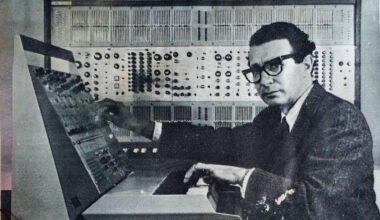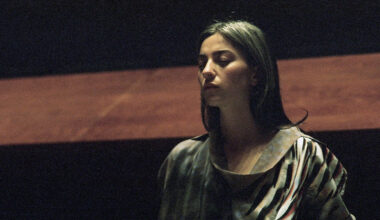Forty years on from their synthpop masterpiece ‘Freedom Of Choice’, Devo’s Jerry Casale and Mark Mothersbaugh reflect on a record made for 1980 whose dire warnings are more relevant today than ever
Devo’s Jerry Casale has been talking a lot. It’s the 40th anniversary of ‘Freedom Of Choice’, the band’s big fat hit album, the one that finally delivered a commercial return for their record label, Warner Brothers. It’s recently been given a special birthday reissue on white vinyl by Rhino.
‘Freedom Of Choice’ is a glossy and bouncy synthpop record, perhaps the first American synthpop album. Clean, tightly synchronised synthesisers dominate the sound, with guitars providing punctuation and colour. The tracks race along with impressive precision, bursting with vitality and efficiency.
The overtly dark eccentricities of Devo’s previous two long-players were replaced with what appeared to be stirring can-do messages of American mid-western optimism. You got freedom o’ choice! When a problem comes along, you can whip it! That’s pep!
This was a record engineered for the 1980s. It was apparently an upbeat manifesto for a new American decade, the five Devo boys on the cover in their smart uniforms, a picture of health and conformity, with the Stars and Stripes hanging either side of them and the whole thing wrapped in red, white and blue. It all looked as wholesome and patriotic as mom’s apple pie.
When ‘Freedom Of Choice’ was released in May 1980, it was only 10 short years after the Kent State University massacre – the event that birthed Devo. In a few horrifying minutes in 1970, at the college campus where both Jerry Casale and his Devo co-founder Mark Mothersbaugh were art students, the National Guard started shooting at demonstrators who were protesting against the bombing of Cambodia, an illegal expansion of the war in Vietnam. Four young people were killed, two of whom were simply walking between classes, and nine were injured. It’s the main reason Jerry Casale has been fielding so many calls from the media in the last few days.
“Devo wouldn’t have existed without those killings at Kent State and me being in the middle of them,” he says. “It was a fork in the road. It’s what led me to a new philosophy and aesthetic.”
That aesthetic became Devo, a post-Warhol, neo-Dada art movement with a dozen or so adherents in Akron, Ohio, which made its point with music, lyrics, masks, costumes, manifestos and plain weird confrontation.
“We saw the forces of tyranny back then – Nixon, the Republican Party, the right-wing media manipulating and conditioning people – and we saw a consolidation of power,” continues Jerry. “We were warning people, like canaries in a coal mine, that they were voluntarily giving up their freedoms by not exercising their brains. Science says, ‘What you don’t use, you lose’, well, no shit. That’s what happened and it’s worse than I could have imagined.”
‘Freedom Of Choice’ wasn’t Devo capitulating to the American way. It was their most cleverly designed attack. It synthesised the Devo critique of the American paradox: you’ve got freedom, but you don’t want it; the girl you want doesn’t want you; the items you desire are not available on the menu; I owe you… absolutely nothing.
‘Freedom Of Choice’ frogmarched its listeners into the 1980s. It chopped through its 12 songs with ultra-disciplined beats, sharp staccato synth basslines and angular top lines, most of the tracks clocking in at under three minutes. It was brisk and efficient. The NME described it as having been put together with “Lego brick logic”, an apt analogy for a work of primary coloured blocks of sound and melodic hygiene. It gave Devo mainstream success and shaped the direction of the rest of their recorded output.
But as Devo prepared to create ‘Freedom Of Choice’, Jerry Casale says the band was on a knife edge. Their second album, 1979’s ‘Duty Now For The Future’, hadn’t been a success and their bosses at Warner Brothers were getting impatient.
“We did ‘Duty Now For The Future’ with Ken Scott – I don’t know how the hell we got talked into that – and that was a mistake,” notes Jerry ruefully. “He was totally the wrong producer. He took those raw, nasty, intense songs and took all the balls out, took all the passion out, and did his little, twee, English-style dissection.”
Quite how the man who produced ‘The Rise And Fall Of Ziggy Stardust And The Spiders From Mars’ could have had such a bad day at the office with Devo is difficult to fathom, but there it is, and it’s probably worth remembering that it takes two to tango. The band were touring ‘Duty Now For The Future’ in the summer of 1979 when they had a visit backstage from a Warner Brothers representative.
“I remember playing the Palladium in New York,” says Jerry, “and this guy from the label had been dispatched to come and tell us that unless we were successful with the next record – our third record, which would become ‘Freedom Of Choice’ – then it was over. The label were not going to honour our contract. The guy said, ‘Look, you can sue them, but you don’t have the money to fight Warner Brothers and I guarantee you won’t win’. He tells us this right before we go onstage!”
It wasn’t the emissary’s ultimatum that changed Devo’s tune, however.
“If people think we went into the studio with that motivating us, they’d be wrong,” laughs Jerry. “The label were barking up the wrong tree. The Devo guys weren’t going to take the bait. We didn’t respond to threats of that kind, especially from these people, who were such an illegitimate authority to us. We’d been thinking about moving away from the sound that we had mined for so long anyway, so ‘Freedom Of Choice’ was like, ‘Fuck it, if this is going to be our last record, if Warners are going to boot us, let’s do what we want to do’. If it was going to be over, OK, fine, but we wanted it to be over on our terms.”
Mark Mothersbaugh, interviewed here separately (as is the protocol with Devo these days), remembers the build-up to ‘Freedom Of Choice’ differently.
“I was in a good place at that point,” he says brightly. “I felt that what we were doing, we were doing well. Any of the politics with Warner Brothers didn’t faze me because we spent very little money. We were very cost conscious. Even when we had a record deal, we decided to pay ourselves the same amount of money that a school teacher got. Nobody was taking out money to buy limos or houses. We were always on a budget. And that was agreeable with me, that’s the way I wanted it. As far as any of the intrigue with what Warners were getting or thinking or doing, they’re a record company and they all have a good side and a bad side. I never expected them to fully appreciate our vision – and they demonstrated that to us early on. Even on the first album, we already knew.”
As the 1970s burned out, the band’s mutated songs and pre-punk/post-punk deconstructions of the rock ’n’ roll canon had served them well enough, but the time had come for a fresh Devo sound, one that would suit the next decade.
“We had talked about me switching over to a Moog bass instead of a bass guitar,” says Jerry, “and we’d talked about using Devo versions of R&B beats, sort of Devo meets James Brown, like funky robots! We were living in Los Angeles, seeing different things and hearing different things. I’m driving around listening to Prince. Bob Mothersbaugh [Devo’s guitarist] and I were big fans. We collected early R&B and we’d listen to James Brown, so we were pushing it in that direction, and Mark was really excited about going that way.”
“We were paying attention to disco and funk and electronic music, to all the music that was out there,” says Mark. “And we thought, ‘Well, what would Devo’s version of funk be?’. We already obviously had this robotic persona. We wanted to look like the guys that would flag an aeroplane into the loading dock, take off the baggage, fuel up the plane, and send it off again. So we wanted to add funk to that. If you listen to it and think, ‘Oh, they were trying to be funky’, you can laugh, because that’s about as funky as these five guys from Ohio could get.”
The new work, then, would be electronic, rhythmic and subversive.
“‘Freedom Of Choice’ was the first time we hadn’t already written the bulk of the material back in Akron,” continues Mark. “It was the first album we’d written entirely in California. We had sequencers on a couple of pieces on our debut record and we liked using sequenced synths along with playing, because it could free you up to do things musically where you didn’t have to carry all the weight with guitar, bass and drums.
“With the lyrics, we were still in the same world we’d always been in thematically. But we’d already said, ‘Are we not men? We are Devo!’ and ‘We’re the smart patrol, nowhere to go’. By the time we got to this album, we were watching a lot of dumbing down going on in our country and we saw that people thought being patriotic meant mindlessly obeying the rulers. Devo came from the opposite side of that. We were saying, ‘OK, if rebellion doesn’t work, what does work and who changes things?’. We thought of it as subversion and that’s how we ended up in Hollywood. Go to the belly of the beast. When we got to the third album, I felt as though we were accomplishing that.”

The tracks that made up ‘Freedom Of Choice’ came together during rehearsals in Hollywood in the last couple of months of 1979.
“We had this little storefront with the window painted over and we just set up inside there,” remembers Mark. “We had it for two months. It was an interesting place because there were other storefronts, with different bands coming in and out rehearsing. There was this one big room, it later became the Hollywood shop for Amoeba Music, and Pink Floyd were in there. They were throwing away old empty cases and some broken mic stands, they were going in the trash, and then this wooden box that was a synthesiser went in the trash. I went over and it was an Ondioline! So I put the Ondioline on Devo tracks and things like ‘Pee-wee’s Playhouse’ for years because of that.”
Alongside the Ondioline, the Devo synth arsenal for ‘Freedom Of Choice’ included two Minimoogs Mark had been playing for years, an ARP Odyssey, and an EML ElectroComp 500 with a PolyBox, a device that emulated polyphony.
“It was impossible to tune it properly,” says Mark. “But it was the one we got out for the song ‘Freedom Of Choice’. It made that beautiful factory noise at the beginning. We felt as if we were in the rubber factories in Akron. I also used it for the whip crack sound on ‘Whip It’. It was such a wimpy whip crack! Luckily, there weren’t many whip cracks out before that, so we squeezed by with it.”
The band also had sequencers by ARP and Moog, as well as the Roland System 100M sequencer, and they mixed them with live playing.
“There was something about playing to sequencers. Alan Myers [Devo’s drummer] was very good at that. You play a little warmer but not quite as accurately, because you’ve got this instrument that gives you the room to bring personality into the sound with your other gear. So somehow that really appealed to us. We wanted this precision feel to our music, but we also wanted to keep what we had.”
But who to produce the group’s different direction? The stellar names they’d worked with previously had given them mixed results. The third-time-lucky choice was Robert Margouleff. As half of the experimental electronic music duo Tonto’s Expanding Head Band with Malcolm Cecil, Margouleff had worked with Stevie Wonder in the early 1970s on three of his most sublime albums, ‘Music Of My Mind’, ‘Talking Book’ and ‘Innervisions’.
“We teamed up with Bob Margouleff because he’d worked with Stevie Wonder,” says Jerry. “With synthesisers and Moog basses!”
On the face of it, Devo and Margouleff seemed an unlikely pairing, but it worked perfectly.
“He had invented this machine called TONTO, which was supposed to be the first polyphonic synth,” notes Mark. “And it was beautiful. He made these rack-mounted cabinets that made you feel you were inside an orb. It was almost as if you were inside a Sputnik cabin. You were a cosmonaut when you played that thing. Bob turned out to be very helpful and knowledgeable and full of positive energy. He showed us how to do things. He showed us recording tricks that upped the ante for us.”
“I don’t think he knew much about Devo before working with us,” adds Jerry, “but we played him some demos and that sealed the deal. I don’t think he particularly liked or disliked what we had done before. He liked it conceptually, because he liked a lot of black artists who were really wacky, such as George Clinton, and he thought we were a white version.”
As soon as the studio work got underway, the band were sure they’d made the right choice.
“We loved what Bob was doing with the bass and drum sounds,” continues Jerry. “That punchy, dry, in-your-face feel. But he would keep emphasising, ‘You’ve got to find the mama and the papa, the foot and the answer’. In other words, this funky interplay between bassline, the kick and the snare. It had to be there with nothing else, so we’d strip everything way down again. Unless we loved a track listening to only the bass and drums, then we’d toss it, because it wasn’t cool.”
“Bob brought a lot to it,” agrees Mark. “He really helped us. For the bass, we were always trying to dial it in exactly, and Jerry became exasperated with both his guitar and with the Minimoog. We’d listen to something the next day, after we’d added a few instruments, and it didn’t sound the way we thought it would. I remember Bob saying, ‘Well, watch this…’, and he took the bass that Jerry was playing and divided it into three outputs – one that was direct and two that went into two different amps with different sounds. I thought, ‘Man! That’s such an easy idea!’. It had never occurred to me that you could do that. We could do subtractive synthesis with it, instead of additive. Bob delighted in showing us things that we didn’t know about. He delighted in showing off his studio prowess.”
’Freedom Of Choice’ was recorded in late 1979 and early 1980 in Los Angeles, at the Record Plant’s Studio B.
“It was the cheapest place with a good-sized live room,” says Mark. “We would start at about five or six in the evening, because it was cheaper to record at night than in the day. Little Richard was working on an album during the day in this room. He was pretty cute. He told us the same story again and again, about how nobody gave him credit for inventing rock ’n’ roll and listing all the things he’d done before The Beatles did them, forgetting that he’d already told us this before. It was awesome. It was great to see him every day, telling the same story!”
Mark Mothersbaugh and Bob Margouleff’s relationship endured way beyond ‘Freedom Of Choice’, with the producer rebuilding TONTO in Mark’s LA studio on Sunset Boulevard in the 1990s.
“It was here for a few years until Bob and Malcolm Cecil remembered why they’d stopped working together,” chuckles Mark. “And then Malcolm showed up one day, packed up TONTO, stuck it in a U-Haul, and took off!”

When ‘Freedom Of Choice’ was delivered, the executives at Warner Brothers thought they had a hit single in the shape of ‘Girl U Want’. The energetic and catchy hymn to unrequited love opened the album, the staccato guitar riff not a million miles from Devo’s version of The Rolling Stones’ ‘(I Can’t Get No) Satisfaction’, which had turned so many heads in 1978. It also sounded a bit like ‘My Sharona’, The Knack’s monster international bestseller. It had a danceable beat, a thudding Moog bassline, and a timeless lyric for lovelorn teenagers everywhere. It had “hit” written all over it.
“Of all the songs we had, we believed ‘Girl U Want’ was the one most likely to get played on the radio,” confirms Mark. “The inspiration for the lyrics came from Scotland, of all places. We were doing a tour there when I looked in the window of a religious store and saw this book. It looked like a comic book almost and it was called ‘The Girl You Want’. It was a short story that turned into a religious parable. But in the beginning, the story was about an advert for a delivery boy in a grocer’s window that said, ‘Boy Wanted’, and a girl came in and applied for the job. She said, ‘Don’t forget about girls!’, or something to that effect, and that became the lead line. We thought, ‘Well, that’s not like calling people apes or telling everyone that they’re tearing the world down…’.”
Devo made a video for ‘Girl U Want’, a pastiche of a 1960s TV pop show performance. The audience of teenage girls are barely able to contain their excitement as Devo perform in their strange outfits – metallic grey suits made of Naugahyde, a synthetic fabric commonly used for bar stools, with flowerpot-shaped “energy domes” on their heads – flanked by two robotic body-popping dancers. The look was another nod to the R&B influence on their music.
“We were looking at image banks of old R&B record covers and the bands from the late 50s and early 60s were all in these iridescent, glittery suits,” says Jerry. “We focused on this one black R&B group – and this was a style that you could see across the board when you looked at a bunch of pictures – and they had one-button suit jackets with narrow lapels and matching pants. They were wearing turtlenecks underneath. I knew some costume people who worked in movies and when they showed me that silver Naugahyde, I said, ‘That’s it! We’re doing that!’.
“Once we had the suits, we were thinking, ‘What are we going to do? How are we going to make ourselves even more uniform?’. That’s where the hats came in. I had always been into that shape because it was the same as a ceiling fixture in my grade school. If you imagine the hat turned upside down, it was a ceiling fixture hanging from three chains, and it was everywhere in my school. It had been built in the 1930s and there was a lot of art deco touches, with these glass fixtures through the hallways and in the rooms.
“The hat thing had been around a long time with us. As to why we were deciding to put anything on our heads, that was a general conversation that had started years earlier, but we’d never done anything about it. Bob Mothersbaugh was a comic book collector and he had this comic, I think it was ‘Little Lulu’, and there was an episode where Little Lulu is walking around school in a ‘cancellation helmet’ because she can’t stand the dumb things that these kids are saying all the time, she wants to protect herself from them, and it was basically a red version of a ziggurat. It was close to the shape that I was in love with already, but it was red. The suits were R&B inspired, but were more the Tin Man out of ‘The Wizard Of Oz’, and then the red hats were a nice contrast. I didn’t go with turtlenecks, though, I searched back to the early 60s boat necks.”
Despite the strong image, the catchy song, the intriguing video, and Warners’ best marketing efforts, ‘Girl U Want’ didn’t sell. The guillotine blade was poised to descend on Devo’s prospects. But unknown and unpredictable forces were about to come into play, changing the course of Devo’s trajectory and pulling them out of the nosedive they seemed to be in.
“So Warners had put their machine into action where they never really had for Devo before,” says Jerry. “They went to radio with ‘Girl U Want’ and it stiffed! And that was that. It was our last shot. We were done. We had to go on tour anyway, still playing four or five hundred seaters, except in the major cities where we could get a larger crowd, maybe two or three thousand people. And while we were rehearsing for the tour, we got word that Kal Rudman, who’s this radio programmer, a DJ guy down in Florida and a big deal in the whole South-Eastern United States, had gone nuts for ‘Whip It’!
“Because Kal Rudman personally thought ‘Whip It’ was a great song, he pushed it on a bunch of radio stations and other DJs began picking it up. Then it started spreading out like a virus. It hit NYC, at which point we had to stop what we were doing and rebook all the venues, because this song was taking off. The promoter was saying, ‘Listen, we sold this thing out in an hour. We’re going to have to book bigger places’. So everything changed, everything changed…”
After the dustbowl that was Devo’s chart performance throughout 1979, ‘Whip It’ was issued as a single in August 1980 and was a US Top 20 hit, making it to Number 14 in November. ‘Freedom Of Choice’, which had charted at Number 65 on its release and then started dropping, began climbing again and stayed in the album charts for the rest of the year, peaking at Number 22 in December.
“We were kind of amused,” says Jerry. “Devo didn’t sit down and try to cynically write hits. We were artists making music, so we didn’t put anything on that album that we didn’t like. That was the first rule. So it’s not as if we loved ‘Girl U Want’ and didn’t care about ‘Whip It’. We thought they were both great! So it was like, ‘Oh, OK, you guys decided that ‘Whip It’ is it? OK, thank you’. There wasn’t any song on that record that we didn’t want played.”
One of the less edifying reasons for its success appears to be a chunk of the US demographic thinking that ‘Whip It’ was a comedy song either about S&M or about wanking. Or both.
“So we were touring in America as that song became a hit,” continues Jerry, “and we were sent to every fucking radio station in every town. We’d get off the plane and we had to go to the radio station, we didn’t get to go to the hotel. Here’s these guys with hippy hair and mutton chops and satin jackets, guys who were still getting coke and whores, and they’d go, ‘Hey, whip it!’, and they’d all do the jerk-off move. They were convinced it was a song about beating off or whipping a female.”
Devo responded by making a notorious promo video for ‘Whip It’ that plays up to this fundamental misreading of the song. Set in a cartoonish Wild West cowboy context, Devo perform the track corralled like livestock, Moogs strapped around their shoulders, energy domes floating on their heads, while Mark Mothersbaugh removes the clothing of a woman, carnival-style, with a whip. A group of good ol’ boys and girls watch, hollering and drinking beer.
“I thought, ‘Well, this is what they all think’,” says Jerry. “They didn’t pay any attention and they got really bummed when we tried to explain where the song came from, because it’s not a story they’re keen on. So we decided to create that video on purpose to feed their misunderstanding. And it worked great. They loved it! We went for it, Devo being satirical and having our cake and eating it too, by feeding their dumbed-down expectations.”
‘Whip It’ was actually a wry comment on the myth of the American can-do spirit, as personified in the 19th century young adult fiction of Horatio Alger, whose protagonists came from poor backgrounds to achieve success and middle class respectability through hard work and determination.
“When I wrote those lyrics, I’d been reading Thomas Pynchon’s ‘Gravity’s Rainbow’,” explains Jerry. “Pynchon had a bunch of poems and limericks that were all skewering this bullshit propaganda – Disney World, Americana, Horatio Alger – that the facade of the American brand is based on. And I thought, ‘I want to do one of those! I love this, this is making me laugh, let me see if I can do one’. So one night in my bedroom, I knocked out my version of Thomas Pynchon making fun of Horatio Alger.”

Ironically, Devo themselves personify the concept of progress through hard work, albeit in a twisted and satirical manner. Working class lads from America’s blue-collar Rust Belt, they’d had their noses to the grindstone for years before widespread success arrived. Now Devo’s noses were at the coke mirror, as they were granted full access to the gilded horrors of the LA music industry’s insiders’ club.
Jerry paints a vivid picture of life as a band with a hit album under their energy domes. It’s a long way from the dive bars of Akron, filled with rubber factory workers and unemployed Vietnam vets, where Devo started out.
“We would go to meetings with the record company and, you know, our A&R man would say, ‘Oh! It’s five o’clock. Time for a cocktail! Guys, you interested?’. He had one of those old-style desks, like in ‘Mad Men’, where there’s a flat piece of wood that would pull out as a platform for a typewriter. So he slides it out and he’s got a mirror Scotch-taped to the surface. And then from the drawer where his pens and pencils are, he gets out his vial of coke. And he taps it on the glass and goes, ‘Cocktail hour!’. And nobody thought twice about this. This was normal. So everybody would do a couple of lines and keep talking.
“There was also a place called Roy’s, which was a famous watering hole for all the music business. It was on Sunset Boulevard, a nice restaurant, open all day, and they had booths that were a couple of steps up from the main floor where the tables were. If you were connected or you’re Devo and you go there with Elliot Roberts, your manager, you get one of the booths, which had curtains you could draw shut. And the waiters were coke dealers, because this place was near a huge parking lot where the valets were famous for high quality blow, so the waiters would have the blow and they’d say, ‘Anybody want dessert? We have some… snowflake’, or something like that. There’d be a wink and a nod, and a plate would come with a napkin over it, and there were lines cut on the plate. And the waiter would close the curtain and we’d have lines at the end of lunch. Nobody was laughing or anything. It was just, ‘OK, this is how it works’.”
‘Freedom Of Choice’ has the longest tail of any Devo album. Synthpop never quite took off in the US in the way it did in the UK, but its electronic sound became a part of the DNA of mid-80s mainstream American pop. Its strong underground roots underpinned the later success of groups such as Nine Inch Nails and Ministry, while the electronic music coming out of Detroit, although influenced by European artists like Kraftwerk and Gary Numan, found part of its US audience among those who had sent ‘Freedom Of Choice’ into the charts.
In 1992, Nirvana covered ‘Turn Around’, the B-side of the US release of ‘Whip It’, introducing another generation of fans to Devo’s music and revealing Kurt Cobain’s appreciation of the band’s critique of American culture. The Flaming Lips, Moby, Robert Palmer, The Breeders, Soundgarden, Pearl Jam, Superchunk, Yo La Tengo and Ministry have all recorded or performed covers of tracks from ‘Freedom Of Choice’.
‘Whip It’ has meanwhile continued to infiltrate the mainstream over the decades. It’s in an episode of ‘The Simpsons’, it’s referenced in the Austin Powers/Dr Evil “zip it” gag, and it’s been used for many TV adverts, including Swiffer cleaning products (“When you got a dirty floor / Use a Swiffer”). The lyric “whip it” has become “flip it”, “chip it” and “dip it” for a variety of consumer products.
The song ‘Freedom Of Choice’ itself was used in a Miller beer advert in 2003. Taking the lyric at face value, it entirely missed the point that it’s about the illusion of freedom and calling out phoney choices between identical products in a so-called free-market economy. Even as the album came out in the summer of 1980, in a piece of bizarre synergy, a hamburger chain ran a billboard campaign around California featuring four slightly different hamburgers under the slogan – yes, you guessed it – “Freedom Of Choice”.
“It was the same Devo joke,” laughs Mark, “because it was all shit fast food! We thought, ‘That’s an awesome billboard…’. The more crap adverts use ‘Freedom Of Choice’ to help sell their products, the more Devo it all gets.”
When the band toured to mark the 30th anniversary of ‘Freedom Of Choice’ in 2010, they played the album in its entirety. A few years later, in 2017, ‘Whip It’ popped up in the second season of the 80s homage Netflix blockbuster ‘Stranger Things’. How do Jerry and Mark account for the album’s longevity?
“Well, I guess it was prescient,” replies Jerry. “I guess the fact that people are interested in it at all shows that if you do something right, it lasts. I mean, we did as much as we could for as long as we could, and when your work has some substance to it, it can go beyond its trendy moment in time. And now here we are, with all the warnings that were on that record, including the title track, coming true. And I don’t think Humpty Dumpty can be put back together again. I think that even if people go and vote, it won’t matter, because the voting system is so rigged, so corrupt, that between voter suppression and gerrymandering and hacking, the president will be installed again. Your vote does not count. We didn’t use our ‘freedom of choice’ and we lost it.”
“We named it ‘Freedom Of Choice’ for a reason,” says Mark. “It was the song that summed up what we were thinking and what we felt was a message that we wanted to share with the world.”
In an alternate universe, the success of ‘Freedom Of Choice’ would establish Devo as the new benchmark American band, a band that would define a decade of bright ideas articulated through smart pop. Their 1981 follow-up album, ‘New Traditionalists’, would live in the Top 10 on both sides of the Atlantic for most of that year and Devo would present their audio-visual ideas to stadiums full of excited fans.
Alas, in this universe, ‘Freedom Of Choice’ was as good as it got for Devo. Despite at least two more excellent albums of electronic Devo-lution, mainstream America turned its attention to the joys of Reaganomics and the Live Aid hegemony.
Freedom of choice is what you got… freedom from choice is what you want.
The 40th anniversary reissue of ‘Freedom Of Choice’ is on Rhino





